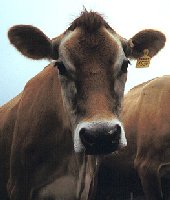

House flies and stable flies are the two primary fly species associated with dairy buildings. Successful house fly and stable fly control can only be accomplished by instituting an integrated fly control program. This type of program utilizes a variety of fly control methods based on a knowledge of pest biology and habits, proper sanitation/manure management and timely applications of insecticides.
Sanitation is the key to any successful fly control program since it removes fly breeding sites. Without proper sanitation, chemical control treatments will be of limited success. Manure should be removed from barns, loafing sheds and especially calf pens at least twice per week during the fly breeding season. It should be spread thinly on crop land with a flail type manure spreader so that it can dry. Manure may also be stored in lagoons or liquid manure pits; however, the liquid manure should be agitated to prevent the breeding of rattailed maggots. Thorough removal of manure from corners, around posts and under feed bunks is necessary to prevent fly breeding in these areas. Rotting hay or straw, silage or other spilled feeds should also be cleaned up regularly. Leaking watering troughs and plumbing should be repaired as needed.
Residual fly sprays should be applied to fly resting areas in barns and loafing sheds to control adult flies. Insecticides applied as space sprays, mists or fogs may be used to provide rapid knockdown of adult flies but have no residual activity and will only control flies present at the time of application. Fly baits also are useful supplements to sprays and sanitation. Feed additives will aid in preventing fly breeding (primarily house flies) in the manure from animals being fed the larvicide. Feed additives should not be relied upon for total fly control.
Larvicides can be applied directly to maggot-infested manure as a means of temporarily reducing fly numbers when sanitation and manure management cannot be used. Rabon 50WP or Ravap EC at the rate of 1 gal of finished spray per 100 ft sq of surface. See label for mixing instructions. Treat only "hot spots" containing large numbers of maggots if possible. Do not spray manure where runoff to soil or water can occur. Do not spray animals with these concentrations.
Screening and other mechanical control methods are invaluable in preventing flies from entering milk rooms and milking parlors. Air curtains are also of some use in keeping flies from entering these areas.
Fly traps can capture large numbers of house flies but generally do not reduce their numbers significantly. Ultraviolet light traps, bottle traps, and fly sticky strips can be useful, particularly in the milk room where pesticide applications are limited and fly numbers are low. The solution to severe fly problems lies in finding and treating or eliminating breeding sites.
Fly parasite release programs Several commercial firms offer a fly parasite release program that can be used to
supplement fly control around concentrated livestock operations. These small wasp parasites lay their eggs in the larvae
or pupae of house flies. The benefits of a parasite release programs in livestock operations have not been proven.
If you try them, include sanitation and chemical treatments with these parasite releases probably will be essential.
See ENTFACT 502, "Biological Control of Flies", for more information.
Rattailed maggots live in highly polluted water such as livestock lagoons and manure pits. Mature larvae crawl
away from the area in which they developed to dry places so that they can transform to the adult stage, a fly. They
become pests when they enter milking parlors or milk rooms. An application of Ravap to the manure pit may provide
very limited control. The crawling larvae will stop in a row of dry soil placed in their path. The soil and maggots can be
shoveled up and discarded.
See ENTFACT 500, "Manure Flies: Rat-tailed Maggots & Moth Flies",
for more information.